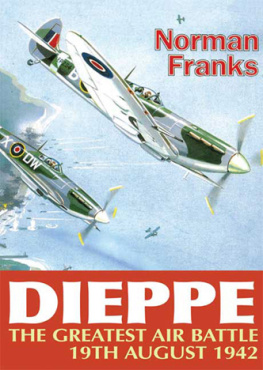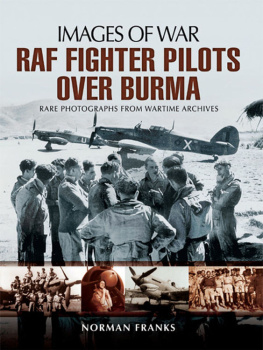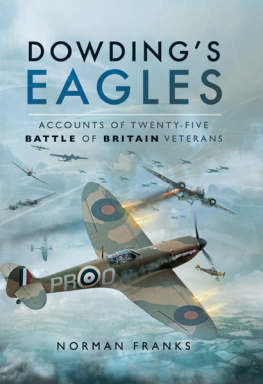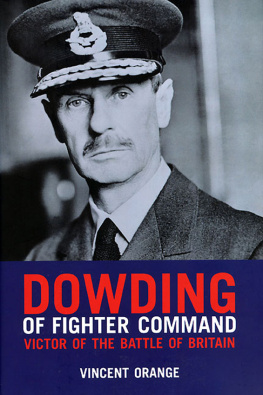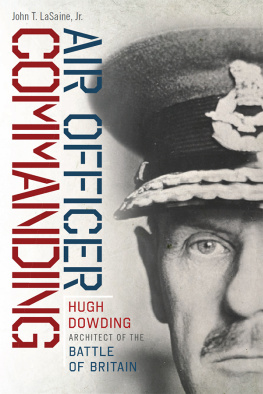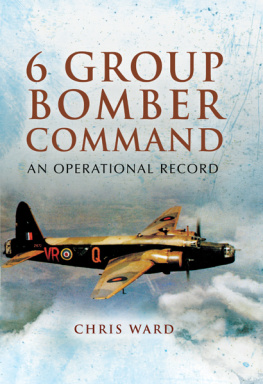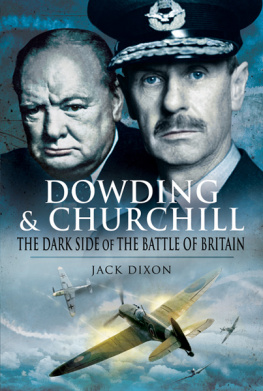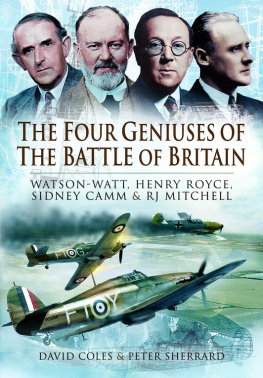

First published in paperback in 1997 by
Grub Street
4 Rainham Close
London
SW11 6SS
Copyright this new edition 2010 Grub Street
Text copyright Norman Franks
A catalogue record for this book is available from the British Library
ISBN 978-1-906502-70-6
ePub ISBN:9781909166509
All rights reserved. No part of this publication may be
reproduced, stored in a retrieval system, or transmitted in any
form or by any means, electronic, mechanical, photocopying,
recording or otherwise, without the prior permission of the
copyright owner.
Front cover painting by Peter Endsleigh Castle
Printed and bound in Great Britain by the MPG Books
Contents
Appendices:
When Canadian troops and British Commandos made their now famous Reconnaissance in force against the harbour town of Dieppe on 19th August 1942, they were supported and protected by the largest array of Royal Air Force aircraft ever seen in WWII until that time. Air Marshal Trafford Leigh-Mallory, AOC of Fighter Commands No. 11 Group, was given command of the air operation and had 46 Spitfire, 8 Hurricane, 3 Typhoon and 4 Mustang squadrons under his direction, as well as 7 Boston and Blenheim squadrons of 2 Group and Fighter Command. On 19th August Leigh-Mallory commanded more squadrons than were available to Air Chief-Marshal Hugh Dowding at any one time during the Battle of Britain two years previously.
This book provides a detailed, minute by minute, hour by hour, blow by blow account of operations on a day which has become accepted as the one on which the Royal Air Force fought its greatest air battle.
The RAF flew nearly 3,000 sorties: the Luftwaffe 945. Air combat, ground attacks, bombing and smoke laying missions cost the RAF over 100 aircraft and the Luftwaffe nearly 50. All this happened in just 16 hours. In addition to the in-depth research into the RAFs activities on 19th August 1942, there are also many personal accounts from pilots who took part, adding colour to the story of this unique day in the history of the Royal Air Force.
Norman Franks is a full time author and air historian. His other books, published by Grub Street, are:
Above the Lines (with Frank Bailey and Russell Guest)
Above the Trenches (with Christopher Shores and Russell Guest)
Above the Trenches Updated Supplement (with Christopher Shores and Russell Guest) Battle of the Airfields
Bloody April, Black September (with Frank Bailey and Russell Guest) Fighter Pilots Summer (with Wing Commander Paul Richey) Over the Front (with Frank Bailey)
Search, Find and Kill
Spitfire Offensive (with Wing Commander R Sampson OBE, DFC & Bar)
Tempest Pilot (with Squadron Leader C J Sheddan DFC)
The Jasta Pilots (with Frank Bailey and Rick Duiven)
Under the Guns of the Red Baron (with Hal Giblin and Nigel McCrery)
War Diaries of Neville Duke
Who Downed the Aces in WW1?
List of Illustrations
Maps
Acknowledgements
During the research and writing of this book I have been privileged to meet and correspond with a number of men who flew at Dieppe. Each one in his own way has made a useful contribution and to each and everyone of them I am more than grateful. My sincere thanks, therefore, go to:
Air Chief Marshal Sir Harry Broadhurst, GGB, KBE, DSO, DFG, AFG(11 Group, Fighter Command)
Air Vice Marshal David Scott-Maiden, DSO, DFC (North Weald Wing Leader)
Group Captain Myles Duke-Woolley, DSO, DFG (Debden Wing Leader)
Group Captain Denys Gillam, DSO, DFC, AFC (Duxford Wing Leader)
Mr Eric Beverley, DFC (13 Squadron)
Lieutenant Colonel Harold Strickland (71 Eagle Squadron)
Air Chief Marshal Sir Denis Smallwood, GBE, KCB, DSO, DFC (87Squadron)
Mr Frank Mitchell (87 Squadron)
Mr Stuart Hordern (87 Squadron)
Group Captain James Pelly-Fry, DSO (88 Squadron)
Group Captain Desmond Griffiths, DFC (88 Squadron)
Flight Lieutenant T. H. J. Cairns, DFC, DFM (88 Squadron)
Wing Commander Minden Blake, DSO, DFC (130 Squadron)
Group Captain Peter Simpson, DSO, DFC (130 Squadron)
Group Captain Michael Pedley, DSO, OBE, DFC (131 Squadron)
Captain Richard L. Alexander (133 Eagle Squadron)
Mr John Brooks, DFC, DFM (174 Squadron)
Air Vice Marshal Graham Magill, CB, GBE, DFG (226 Squadron)
Air Commodore Peter Donkin, GBE, DSO (239 Squadron)
Air Commodore John Ellacombe, CB, DFC, MBIM (253 Squadron)
Major General Helge Mehre, DSO, DFC (331 Norwegian Squadron)
Major General Svein Heglund, DSO, DFC (331 Norwegian Squadron)
Lieutenant General Wilhelm Mohr, DFC (332 Norwegian Squadron)
Captain Per Bergsland (332 Norwegian Squadron)
Captain Marius Erikson, DFM (332 Norwegian Squadron)
Senator John Godfrey (412 Canadian Squadron)
Air Commodore Peter Brothers, CBE, DSO, DFC (602 Squadron)
Wing Commander Roland Beamont, CBE, DSO, DFC, DL, FRACS (609 Squadron)
Air Chief Marshal Sir Dennis Crowley-Milling, KCB, CBE, DSO,DFC, AE (610 Squadron)
Air Vice Marshal Johnnie Johnson, CB, CBE, DSO, DFC (610 Squadron)
I also thank the Ministry of Defence (Air), Staff of the Public Records Office, Imperial War Museum, Norwegian Forsvaramuseet, Oslo. Also to my friend Chaz Bowyer, for his continued confidence, Herr Hans Ring for his kind information, to Martyn Ford-Jones for his maps, to Amy Howlett of William Kim-bers for her enthusiasm, and as always to my wife Kate for far more than her ability to spell. Finally to my two sons, Rob and Mike, for providing cups of coffee.
'So intense has been the battle that I have had to make far greater calls on all squadrons than I ever anticipated, or I would have imagined you could have undertaken. I thank you for your cheerfulness and keenness with which all sorties were carried out and congratulate you all most heartily upon the brilliant result of the day's fighting.'
Trafford Leigh-Mallory
Introduction
Much has been written about the Dieppe Raid which took place on Wednesday, 19 August 1942. The gallantry of the Canadians at Dieppe has been recorded in great detail as well as the raids by the Commando forces on the flanking gun positions. What is less well recorded or documented is the great air effort which took place on that day in direct support of Operation Jubilee. This book is an attempt to put the air side on record.
By the end of that August day in 1942, the Royal Air Force and the German Luftwaffe had fought what must be regarded as the greatest air battle of the war if only in terms of aeroplanes lost in combat on both sides in the space of just sixteen hours. Despite the tragic losses suffered by the Canadian troops on the ground, the RAF claimed a great victory that day.
*
The plan to launch a raid on the French coastal town of Dieppe was conceived early in April 1942, the thirty-second month of the war, at Combined Operations Headquarters. Following a long study of the practicability of such an enterprise, an outline plan was drafted and produced on 13 May. This plan was formally approved by the Chiefs of Staff.
In general terms the plan was to land a force of troops at Dieppe, supported by landings by Commandos on the flanks to knock-out gun positions overlooking the Dieppe beaches. Following much discussion it was decided not to precede the landings with either an air attack or heavy naval bombardment, nor was it agreed to use any form of airborne troops, although the landed troops would be given the support of a number of the new Churchill tanks.
Next page
